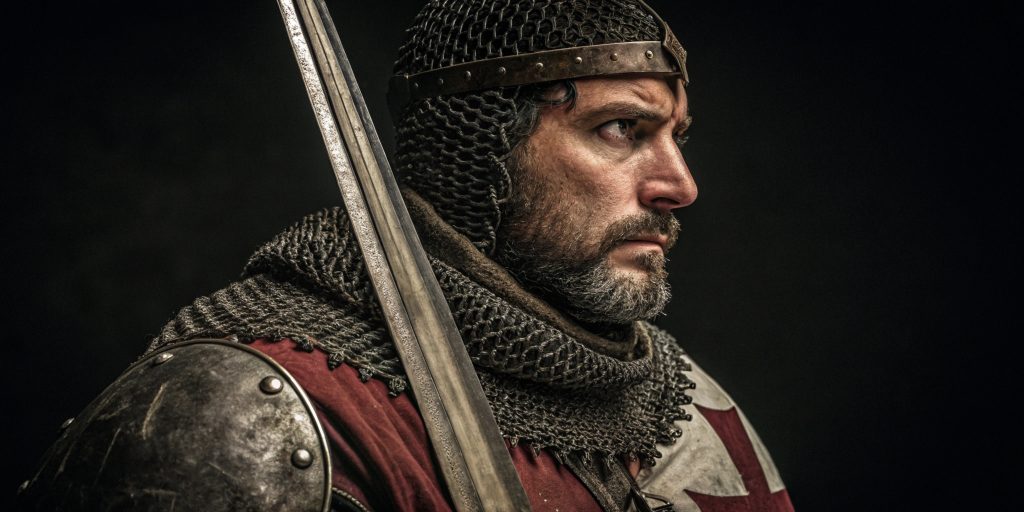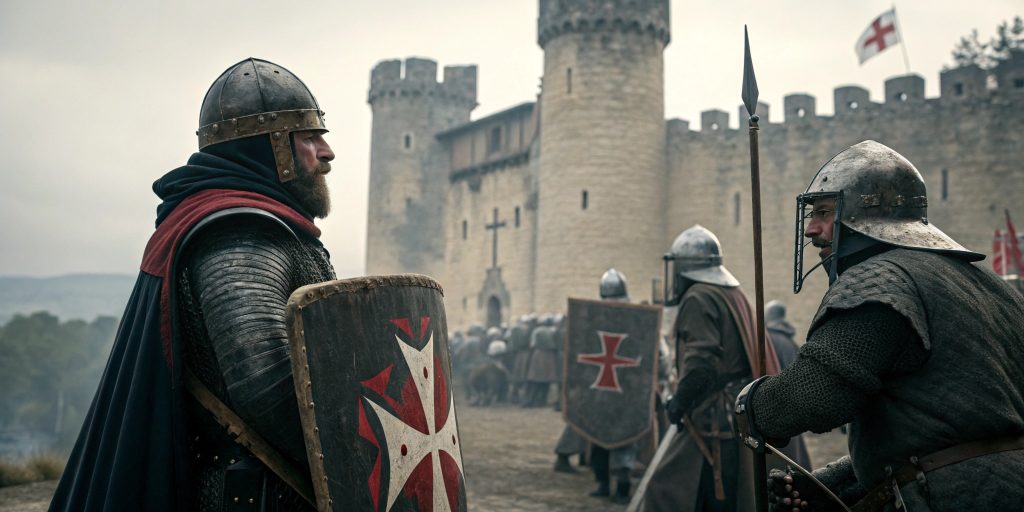The bond between French knights and the Templar Order in medieval France is fascinating. French knights, known for their honor, greatly shaped the Templar way. They influenced their operations and strategies to avoid defeat.
As the Templar Order grew, it adopted many French traditions, reflecting the influence of medieval French knights. This article explores how these interactions created a special mix of culture and tactics and shows how French knights deeply influenced the Templar Order in the Middle Ages.
Introduction to the Templar Order
The Knights Templar started in the early 12th century. They were a key Christian military group. A small group of knights founded them to protect pilgrims going to the Holy Land during the Crusades.
As they grew, they became known for their bravery and honor. They were seen as symbols of strength and nobility.
The Templars followed strict rules, showing their commitment to faith and duty. They stood out in medieval Europe, balancing their warrior roles with their religious goals.
They fought in many battles during the Crusades. This put them in a tough spot between European and Islamic forces. Their role in medieval warfare is still studied and admired today.
Historical Context of French Medieval Knights
The history of French knights is deeply connected to the rise of French nobility in medieval Europe. The feudal system was key to this growth. It helped create military and social structures that shaped the era.
Land ownership became a sign of power. French knights worked to build wealth and status during France’s medieval period. This was crucial for their influence in society.
The Rise of French Nobility in Medieval Europe
In medieval Europe, the rise of French nobility changed power and influence. This change came from the feudal system, which valued land and loyalty. As noble families grew their lands, they promoted a culture of chivalry among the medieval knights.
This led to:
- Strict codes of conduct.
- A focus on honor and bravery in battle.
- Building alliances through marriage and service.
Key Figures in the Era of French Knights
The era of French knights saw many notable figures. They played key roles in the Crusades and military campaigns throughout France during the Hundred Years War. Some of these leaders were:
- Godfrey of Bouillon, a skilled military strategist.
- Richard the Lionheart is known for his bravery and leadership.
These famous crusader knights embodied the ideals of their time. They also shaped the military culture associated with the Templar Order and its connection to French royal interests. Their legacies give us insights into the strategies and values of French knighthood in the medieval era.
Cultural Exchange: French Knights and the Templars
The medieval French knights and the Templar Order had a deep cultural exchange that shaped both groups. It made the chivalric codes richer and helped form the Templar way of life.
Influence of Chivalric Codes
Chivalric codes greatly influenced the Knights Templar’s rules. These codes stood for honor, bravery, and loyalty. These values of medieval chivalry became key for knights in medieval times.
Templars used these values in their daily life and battles. This helped define their beliefs and actions.
French Literature and Templar Ideals
French literature, like “Chanson de Roland,” was vital in shaping Templar ideals. These stories were full of bravery and faith. They matched the Templar mission well.
Through literature, French knights and Templars shared values. This helped them understand each other better.
Military Tactics of French Medieval Knights
French knights were key in medieval warfare, especially in battles like Crecy. They divided battles into cavalry and infantry. This helped the French nobility win many fights.

Cavalry vs. Infantry: A Tactical Overview
The French cavalry was mighty. They were well-armed and rode horses, which made them fast and strong on the battlefield. They embody the ideals of knightly valor.
Infantry was important, too. They held their ground and supported the cavalry, but facing armored knights was difficult.
What made cavalry tactics work included:
- Mobility: They could move fast to find weak spots in enemy lines.
- Shock Impact: Their charge could scare infantry troops.
- Heightened Advantage: Riding high, knights could hit targets and morale well.
The Role of Archers in Battle
Archers were crucial for French knights. They used longbows to shoot from far away, helping soften the enemy before the cavalry attacked.
Archers played a big role in battles during France’s Hundred Years War. They included:
- Effective Suppression: They could bother enemy infantry before a fight.
- Support for Cavalry: They could attack enemy archers or groups, helping the knights.
- Adaptability: They could change from attacking to defending, making strategies more flexible.
The teamwork between cavalry and archers was vital. It helped the French knights win many battles.
French Knights and the Templar Army Structure
The Knights Templar had a well-organized military setup. They focused a lot on French knights, who were brave and key to the Templars’ success.
They helped the Templars fight well and plan their battles. This made the Templars strong in medieval wars.
Knights Templar as Men-at-Arms
Knights Templar were the main soldiers of the Templar army. They were well-trained in fighting and following the Order’s rules of medieval chivalry. Many were nobles, so they had good training and resources.
They were disciplined and skilled in battle. This made the Templars a potent force on the battlefield.
Integration of French Nobility in the Templar Ranks
French nobles were important in the Templars. They worked well together, helping both sides avoid unnecessary ransom. This made the Templars a powerful force in medieval Europe.
Together, they grew stronger and more influential. They played a big role in feudal service during those times.
French Knights’ Influence on Templar Strategy
French knights were vital in shaping Templar strategies, especially in siege warfare. Their skills from the Holy Land campaigns were crucial to the Templars’ success. Looking at significant sieges, we see how their teamwork improved their battle skills.
Siege Warfare in the Holy Land

Siege warfare in the Holy Land needed new ideas and methods. French knights brought new siege engines and tactics to defeat their enemies. These changes made Templar planning and logistics more important in France during the Hundred Years War. Key sieges show how well they worked together:
- The Siege of Jerusalem (1099) was a big win thanks to teamwork and planning.
- The Siege of Acre (1189-1191) showed how important it was for different groups, especially the French and Templars, to work together.
Decisive Battles and Their Outcomes
French knights fighting with the Templars often changed the battle’s outcome. Their strategies led to big wins that changed the Holy Land’s history. Important battles show their teamwork:
- The Battle of Montgisard (1177) was a big win for the Christians, thanks to their teamwork.
- The Battle of Hattin (1187) was a loss for the Crusaders but taught them valuable lessons for future battles.
These battles made the medieval French knights and Templars famous. They also changed military strategies in the region for a long time, influencing tactics used by French royal forces.
French Knights and the Ideals of Knighthood
The ideals of knighthood deeply influenced medieval French knights in their pursuits. They followed the principles of chivalry, which included honor, loyalty, and bravery. These values guided their actions in battle and society.
Many French knights saw their military service as a sacred duty. They believed they were protecting the faith against the threats posed by the French king. Their religious commitment and dedication to knighthood created a solid moral code.
- Martial duty focused on defending the innocent from the routiers.
- Loyalty to the king and the Church shaped alliances.
- Religious dedication fostered a sense of higher purpose.
French knights played a big role in the Templar Order during the reign of the French king. They spread the values of chivalry, making their military actions more ethical. Living these ideals set a high standard for those in power in their society.
Notable French Knight Names in the Templar Order
Some French knights had a big impact on Templar history. They showed how chivalry and Templar practices were connected. Geoffroi de Charny is a key example of this rich legacy of medieval chivalry.
Geoffroi de Charny: A Legacy of Chivalry
Geoffroi de Charny was a big name in knighthood in the 14th century. He wrote about the importance of honor and doing right in battle, helping shape the Knights Templar’s code of conduct.
De Charny believed in living a good life and being brave. He helped make the Templars known for their honor and courage.
Bertrand du Guesclin and the Art of War
Bertrand du Guesclin was another famous knight. He changed how French and Templar armies fought. He knew how to use the battlefield to his advantage.

His smart tactics helped the Templars deal with tough times during the Hundred Years War. Du Guesclin showed how bravery and strategy could work together.
The Impact of the Hundred Years’ War on Templar Tactics
The Hundred Years’ War changed the way wars were fought. Charles V led this change. It made French knights and Templars change their ways.
This shift moved from old ways of fighting to new, organized methods. These changes were vital for survival on the battlefield.
The Shift in Warfare with Charles V
Charles V changed how wars were fought. He made tactics more flexible and strategic and stopped using heavy cavalry.
He added infantry and ranged units to the mix. This change affected the Templars, making them rethink their old ways.
Lessons Learned from Major Battles like Agincourt and Crécy
Battles like Agincourt and Crécy taught the Templars and medieval French knights much about warfare and strategy. They showed how good longbowmen were and the need for discipline.
These battles taught us the value of working together and being creative. The Templars learned to adapt, setting the stage for future military changes.

